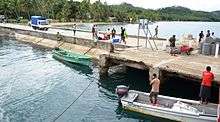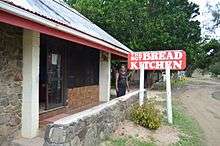Lomaloma
Lomaloma is a district on the Fiji island of Vanua Balavu in the Lau archipelago.[1][2] The village is made up of the Government establishment to the north which includes the Adi Maopa Primary and Secondary Schools, Ratu Sukuna's now defunct home base at Delana, the Hospital and associated quarters for the Doctors and Nurses, the Police Post and Post Office, followed by the village of Delainakorolevu or short for Nakoro – the Fijian part of the settlements, then the village of Sawana, home of Ma'afu and his people the Yavusa Tonga and to the south a smaller settlement called Naqara. The whole establishment is normally referred to as Lomaloma and it is part of the Tikina (tribal district) of Lomaloma which comprises 9 villages, which is further made up of 13 Yavusa (tribes) which are further broken down into 42 Mataqali (Clans) and 54 Tokatoka (Family Units).
From early records first documented in 1881 by the Native Lands and Fisheries Commission there were three Turaga i Taukei (Senior Chiefs) for Lomaloma Tikina listed, namely Ratu Jese Waqalekaleka – Turaga na Rasau, Ma'afu Tui Lau, Roko Tui Lau, Head of the Tovata and also representing Yavusa Toga of Sawana and Jaoti Sugasuga – Turaga Na Ravunisa.[3]
The 9 villages of Lomaloma Tikina are Lomaloma, Sawana, Susui, Narocivo, Namalata, Uruone, Levukana, Dakuilomaloma and Tuvuca.
Village and District titles
Chiefly titles in Lomaloma Tikina are Ravunisa, Rasau, Tui Naturuku, Tui Urone, Tui Levukana, Tui Narocivo, Tui Daku, Tui Susui, Tui Mago(Namalata)and Ramasi(Tuvuca Island).[4]
Sawana the other village within the Lomaloma village and the home of the Yavusa Tonga with their head being the Tui Lau a title that is filled following the recommendation of the Yavusa Tonga and the endorsement of the Tui Nayau from the Vuanirewa clan. Ratu Mara was the last Tui Lau and this position remains vacant pending the formalisation of the position between the Yavusa Tonga and Yavusa Lakeba.
Each of these villages and Yavusa have their own respective Tukutuku Raraba ni Yavusa (Documented tribal history) as referenced in the Native Records.
A brief history
In early Fijian history, Lomaloma village while being small in comparison was considered as the first modern town in Fiji, it was set up by Tongan Chief and Tui Lau Enele Ma'afu as the capital of the Lau Confederacy combining the Lau Group [Lakeba, Nayau, Oneata, Ono, Cicia, Fulaga, Kabara, Vanuavatu, Moce, Namuka and Ogea], Yasayasa Moala Group [Moala, Matuku and Totoya] and the Somosomo Group [Vanuabalavu, Tuvuca, Kanacea, Mago, Naitauba and Yacata]. In Ma'afu's time it also acted as a key port of call between Tonga and Viti Levu.[5]
Ma'afu as the Tui Lau
Lomaloma was made famous in the history of Fiji as it was the base from where Enele Ma'afu waged his campaign under the watchful eye of the Tui Nayau. Ma'afu opted to settle in Lomaloma on the village of Sawana. His installation as the Tui Lau in Lakeba in February 1869 and his assuming control of all Tongan land in Fiji saw his confirmation as a Fijian Chief. Three months later in 1869 at Sawana his position was confirmed when the Chiefs of Cakaudrove, Bua and Lau installed him as Tui Lau and President for life of the Tovata Confederacy as referenced in John Spurnway's Hiki Mo e Faliki, The Journal of Pacific History, Vol 37, No 1,2002
Also of significant in the history of Lomaloma was the event recorded on Easter Friday 1854, when Maafu responded to the startling news to Rev Dr Lyth the resident minister on Lakeba, from Mataiasi Vave a fellow Tongan on Vanua Balavu of a multiple killing – reminiscent of St Bartholomews Day. Seventeen people were murdered in an apparent quarrel over distribution of turtle meat, within the Nakoro clan of Ravunisa. The aggrieved party from the Mataqali Naitasiri of the Yavusa Qala (also the Ravunisa clan), approached relatives in Yaro in Mualevu, who with the co-operation of the Naturuku people, carried out the gruesome killings. Mataiasi Vave and the surviving Ravunisa and Rasau and their people sought refuge in Susui whilst Mataiasi Vave sent his request for assistance to Lakeba – This was referenced in A History of Fiji by RA Derrick and Tovata I&II by AC Reid gives account of Ma'afu's influence in Lau.
Ma'afu and Wainiqolo campaigned in Lomaloma and Vanuabalavu in what has become known as the "Valu ni Lotu". They defeated the "heathens " and on 3 June 1854, Rev Lyth in his diary stated, Ma'afu and his men returned quite unexpectedly from Vanua Balavu and reported the war between the heathens and the Christians has ended in favour of the latter. Ma'afu returned to Lakeba with the murderers [The Naturuku people] to be captives for life, in Lakeba ref Tovata I&II by AC Reid pp 43
In 1855, Ma'afu had acquired sovereignty over northern Lau and established Lomaloma as his base following his exchanges with Tui Cakau Tuikilakila A History of Fiji by RA Derrick pp 131
AC Reid in his book Tovata I&II accounted for the people that resided in Lomaloma when Ma'afu took control of Vanuabalavu who had surrendered to him for protection from the raiders of Mualevu. The 'Tukutuku Raraba ni Yavusa' as referenced in Tovata I&II by AC Reid confirmed that the people of Nakoro were migrants and travellers from other parts of Fiji who settled on the island.
- Yavusa Qala had as its leader the [Ravunisa]. He was brought from Narocivo and installed as their leader even though they had their own traditional Tui Lomaloma title as their head. The Ravunisa was exiled from the Senimoli clan of Yaro later called Mualevu. These were the people that plotted to murder the Ravunisa which resulted in the "Valu ni Lotu". [Motukavonu is where the Mataqali Nadawavula killed the turtle which instigated the murders.]
- Yavusa Buca had as its leader the [Rasau] who was exiled from Bau after a bloody Coup led by the then Vunivalu and travelled along Vanualevu, Somosomo and accidentally landed at Lomaloma. He was welcomed by the Naturuku people and provided shelter and people to care and support them
- Yavusa Naturuku with the Tui Naturuku as its leader came from Vanualevu and landed on the northern part of Vanuabalavu near Daliconi and travelled south dropping off settlers at Levukana to where they finally settled at Delainakorolevu
These three Yavusas settled into their new village called Delainakorolevu, short for Nakoro within the greater settlement of Lomaloma. They are of equal standing within their village of Nakoro
All these three Yavusas left in no doubt about who was in charge with all three surrendering their land and their people as inducement for Ma'afu to conquer Mualevu as reference in Tovata I&II by AC Reid pp 43
Ma'afu when he settled and created his Village called Sawana – he relocated the rest of the people to where they are today and formed the greater settlement called Lomaloma made up of Nakoro, Sawana, Naqara and the settlement to the north to cater for the Colonial government services.

Points of interest
Lomaloma as a Village and as a District is known all over Fiji for a popular song called Lomaloma na toba vakaloloma, which has been sung by various local artists and bands in Fiji. It is also a very popular pub song. The song was composed by Ratu Tevita Uluilakeba Tui Nayau and father of Ratu Sir Kamisese Mara.

One of Fijis largest Bakery chains 'The Hot Bread Kitchen' was set up by a lady of Lomaloma Adi Mere Tuisalalo Samisoni.
See also
Footnotes
- Lau Islands, Fiji By A.M Hocart and Bernice P. Bishop – Museum Bulletin 62, Publication Date: June 1969, Publisher: Kraus Intl Pubns, ISBN 0527021687
- The Cyclopedia of Fiji – Published By The Cyclopedia Company of Fiji, Sydney NSW, 1907 Printers McCorren, Stewart & Co.
- Chart, 1881, Native Registrar Tikina of Lomaloma, NLFC
- Chart, 1881, Native Registrar Tikina of Lomaloma, NLFC
- South Pacific Handbook, Page 360
References
- The Cyclopedia of Fiji – Published by the Cyclopedia Company of Fiji, Sydney NSW, 1907 Printers McCorren, Stewart & Co. – reference to Lomaloma Village, weblink reference to book: Cyclopedia of Fiji
- South Pacific Handbook, by DAVID. STANLEY – 1986, reference to Lomaloma as a key settlement in the early days of sailing.
- Mara, Ratu Sir Kamisese: "The Pacific Way: A Memoir", University of Hawaii Press, 1997
- Tovata I & II By AC Reid, Printed in Fiji by Oceania printers Fiji (1990) reference to the Rasau and Ravunisa, reference to Lomaloma.
- Lau Islands, Fiji By A.M Hocart, Published by the Bishop Museum, Hawaii (1929) reference to Ratu Keni Naulumatua as Rasau of Lomaloma and details on his title.
- The Lau Islands (Fiji) and Their Fairy Tales and Folklore – Page 54, by T[homas] R[eginald] St. Johnston, Published 1918 by The Times book co., ltd.Original from the University of Michigan, Digitized 15 December 2006, reference to The Rasau and the Ravunisa
- Weblink reference to Adi Luisiana Qolikoro
- A web link regarding details of the Native Lands and Fisheries Commission
- The Fiji Islands: a geographical handbook – Page 300, by R. A. (Ronald Albert) Derrick – 1951 – 334 pages
- The Pacific Islands Year Book – Page 203, by John Carter – 1959
External links
- Wiki satellite maps of Vanua Balavu – Lomaloma Village is located towards the lower southern half of the Island.
- Photographs of Lomaloma
- Details and Map of Lomaloma
- Map and some statistical information on Lomaloma.
- A collection of Pictures of Lomaloma, the airport which is at Lomaloma and other pictures on Vanuabalavu around Lomaloma.